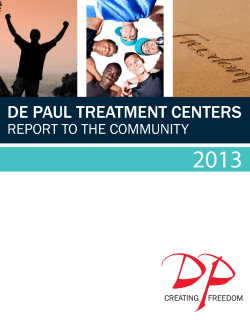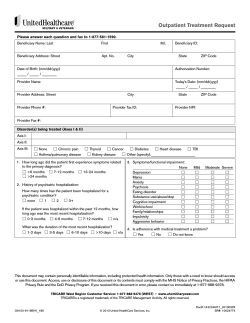
Women’s Health & Urology Ethicon – Article Summary eClinical Compendium
Ethicon Women’s Health & Urology
eClinical Compendium – Article Summary
Title
Randomized Controlled Trial Comparing Thermachoice III in the Outpatient Versus
Daycase Setting
Author(s)
Marsh F, Thewlis J, Duffy S
Source
Fertil Steril 2007;87:642-650
Key
Takeaways
Treatment with GYNECARE THERMACHOICE III Uterine Balloon Therapy System can
be performed successfully in most women in the outpatient setting.
®
There was no significant difference in mean overall pain scores when undergoing
treatment with GYNECARE THERMACHOICE III System in the outpatient or daycase
setting, although there was a wide range of reported pain scores.
Outpatient procedures using GYNECARE THERMACHOICE III System were associated
with less nausea, vomiting, need for antiemetics, and time spent in hospital compared
with the daycase procedure.
STUDY OBJECTIVE:
To evaluate endometrial ablation using GYNECARE THERMACHOICE III System in the outpatient
compared with the daycase setting.
METHODS:
This was a randomized, controlled trial that compared GYNECARE THERMACHOICE III System
performed in women in an outpatient setting while they were awake versus women who were
under general anesthesia in the daycase setting. Enrolled women had menorrhagia for ≥6 months
with a normal scan or hysteroscopy and endometrial sample within the past 12 months.
In the outpatient cohort, women took ibuprofen the evening before and 1 hour before the
GYNECARE THERMACHOICE III System procedure and were offered intraoperative entonox and
postoperative oral tramadol. In the daycase cohort, women underwent a standard general
anesthetic, received intraoperative intravenous fentanyl and rectal diclofenac, and were offered
postoperative tramadol and diclofenac.
Study population
A total of 73 women, mean age 42 years, were randomly allocated to endometrial ablation via the
GYNECARE THERMACHOICE III System in the outpatient (n = 39) or daycase (n = 34) setting.
In the outpatient cohort, 34 women (87%) completed the entire 8-minute treatment; the remaining
five women asked that the procedure be discontinued because of pain. All of the women who
were randomized to the daycase group completed the entire 8-minute procedure.
OUTCOMES MEASURED:
Primary outcome:
x
Overall discomfort after undergoing the procedure (visual analogue scale [VAS] pain scores
and categorical pain intensity scales)
Secondary outcomes:
x
Intraoperative VAS pain scores
x
Need for rescue analgesia with outpatient procedure
(WKLFRQ,QF
1
7&
Ethicon Women’s Health & Urology
eClinical Compendium – Article Summary
x
The following measures were recorded for postoperative recovery: rate of nausea and
vomiting, total time spent in hospital, and postoperative overnight hospital stay
RESULTS:
Overall discomfort after the procedure
x
There was no significant difference between the outpatient and daycase cohorts in overall
mean VAS pain scores; the outpatient cohort had a mean score of 59.1 mm (95% CI, 50.667.6 mm), and the daycase cohort was 52.9 mm (95% CI, 42.0-63.8 mm)
x
No significant differences in the Likert-style descriptions of overall discomfort experienced
between the two groups were shown and most women in both cohorts reported the pain
as absent to moderate (Figure)
OP, outpatient; DC, daycase.
x
The mean VAS pain score reported 30 minutes after a full 8-minute treatment was significantly
lower for the outpatient cohort (24.9 mm) compared to the daycase cohort (40.6 mm, P = .02).
This did not include the 5 women who abandoned treatment
x
In both cohorts, the existence of severe dysmenorrhea was significantly associated (P ≤.05)
with higher overall VAS pain scores
Intraoperative pain during outpatient procedure
x
Mean VAS pain score peaked at 4 minutes of treatment (44 mm; 95% CI, 34.1-54.4 mm;
range, 0-100 mm) and fell to 37 mm (95% CI, 26.8-47.9 mm; range, 0-100 mm) by completion
of treatment
Requirement for rescue analgesia in the outpatient setting
x
Most women (64%; n = 25) did not request any rescue analgesia
x
Ten women (26%) used inhaled nitrous oxide (entonox) intraoperatively, 2 women (5%) had
postoperative tramadol, and 2 women (5%) had both
Recovery
x
Fewer women in the outpatient group versus the daycase group reported nausea (13.2% vs
64.7%, respectively; P <.0005) or vomiting (0 vs 23.5%, respectively; P = .006) or required
postoperative antiemetics (0 vs 55.9%, respectively; P <.0005)
2
(WKLFRQ,QF
Ethicon Women’s Health & Urology
eClinical Compendium – Article Summary
x
The outpatient cohort spent a shorter mean total time in the hospital (1 hour and 40 minutes)
compared with the daycase cohort (8 hours and 12 minutes; P <0.005)
x
All of the women randomized to the outpatient cohort went home on the day of treatment;
however, 2 women who were randomized to the daycase group required an overnight stay
(1 women had persistent pelvic cramping pain, 1 women had antiemetic-resistant nausea)
ADVERSE EVENTS:
See Discussion of Results for information on adverse events reported in the study.
STUDY LIMITATIONS:
A wide range of intraoperative and overall pain scores were reported by women in both cohorts.
3
(WKLFRQ,QF
-%# !! #"(($%
$$ %#!&% !#%! *($ )
-'(!'(&! ##" (#"
*"("(# (("#!(& ""#()(&)'"$&!"#$)' +#!"
+( !"#&& 6,''* )(&" "7 ) (# "" )'' #& +#!
&"'#!$ (2
) * ' #"(&"( #& )' " $("( +# '
$&""( #& +# +"(' (# #! $&""( " ( )()& +"# $ !!' %! #!&$ !# !% !%# %&$,0 +( "#+" #& ')'$(
"#!(& &"#! 6)(&" "&7 #& $&! ""( " # ( "#!(&)!/
')')"&'# *"#!(#)'-$&$ '0+("-"(#!#"(#"6/'(#&-
# $&*#)' '' '&" '(#"' #& (&"'!)& !-#!(#!-7 #& $(# #
#"(#"6/&#"!!)"#')$$&''*(&$-7((#) (#+""#(
!-#!(&)!0+((*"( #&)&"&-(&("(#"(((!#$&#)&6/
&*('/ *"('/ "#!(&('/ ' $"('/ #& -'(('7 #& +( (* $ *
" !!(#&-''6
70+(""(&)(&"*6
7)&&"( -"$ 2
) " ) &!$"4$ * $"0 ")' " *#!("0 #!$ (#"'
+( $&""- 6#(1 "# $ !!' %! #!&$ !# !%
!%# %&$70 "#!(&(' " &'' ''#( +( -'(&#'#$-0 $#'(5
$&#)&'-!$(#!'')'$"/*&/")'/*#!("") (-+((#"
#& !()&(#"0 !(#!(&0 &)$()& # ( )(&)'0 (&! ")&- (# "( ('')0
( %) '$" "(# ( *') & '$' "4#& &*,/ *"/ #$" ()'/
" #!" *(-0 (& )&"0 !#&&0 "(#" #& '$''0 $&#&(#"0
$#'(5 (#" () '(& .(#" '-"&#!0 #!$ (#"' " (# '&#)' ")&- #&
(0*'#5)(&"'() #&!(#"2
) )&(## #+ "'(&)(#"'#&(#"-+&""'#&$&)(#"'
#) &') ("'&#)'$("(")&-2*'"("#&)'#" -"+#!"+#
#"#('&(#& &")'( ###$&""-''""( -
&'# #+"('$&#)&2# $!!' %! #!&$
!#!%!%# %&$2
)(&"$&#&(#"'$&'"(/"($&#)&'"#(
(&!"(/(&! ")&-(#"(('')!-#)&((&'(*(2
"#!(& (#"'"#('(& .(#"$&#)&2("('+#*$&*#)' -
)"&#"() (#"&("&'&'#* #$"$#'( (#"() '(& .(#"'-"&#!+"&%)&-'(&(#!-2"#!(& (#"
$&#)&')'"(
-'(!'#) $&#&!#" -
-! $&#''#" '+#*,$&""$&#&!"$&#)&'+("(
)(&"*(-/')'
"'&(#"#& (#"")&((687/"+#*
%)((&"""! &(-+(
-'(!2
"#!(& (#"$&#)&'#"#( !"(($#("( #&"#!(& -$&$ '#&"#&"#!#("#!(&)!"!-!'($-'"3'
(-(#((#&!"#''#')$(# #-2$&#&!'!5-
9
$&#)&"-'(&#'#$() # )'#"4'(& .(#"2 (#"!-)'"(&)(&"'-"/+"
#!$&#!'6/$&*"(7(:5!#"(#"&!(#"('(67#&(() # )'#"
*2#!"+#*"%)(:5!#"(#"&!(#"('('""#(& -#"(
() # )'#"*#&#"(&$(#"2"" " '()'*"
#")(+!#"'(&((((
9
$&#)&"
' -"(* -$&#&!+(" ((")!() !"'&('"$ 2
#+*&/(
9
$&#)&'#) #" -$&#&!(&
(:5!#"(() # )'#"#"&!(#"('(2
) *& )' #(& #!$#""(' +( ( -'(!2 #& ( #!$ ( '( # &)(#"' ''#( +( ( )' # (' */
#"') ((
-'(!"'(&)(#"'#&)'2," -2
© Copyright 2025












